Research Seminar
Talks about mathematics research being conducted by faculty and/or students from KU or other universities.
2021
Mr. Nate Benjamin, Iowa State University Ph.D. Candidate
"Schurian Association Schemes Obtained from GU(n,q) Acting on Isotropic Vectors"
Tuesday, December 7 at 2:00 pm in Lytle 214
AWM Virtual Research Lecture SEries
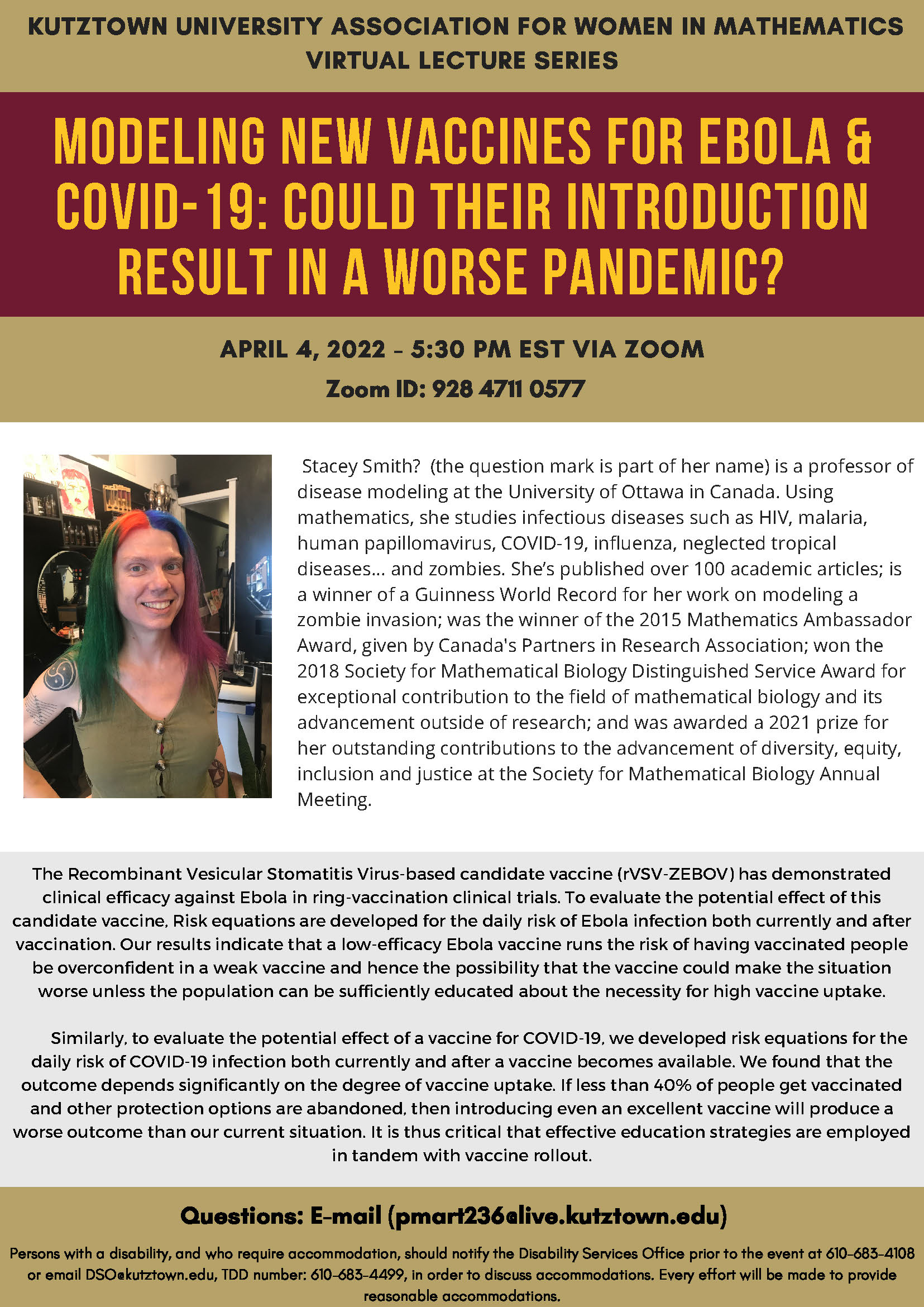
Modeling New Vaccines for Ebola & Covid-19: Could Their Introduction Result in a Worse Pandemic?
April 4, 2022 at 5:30pm
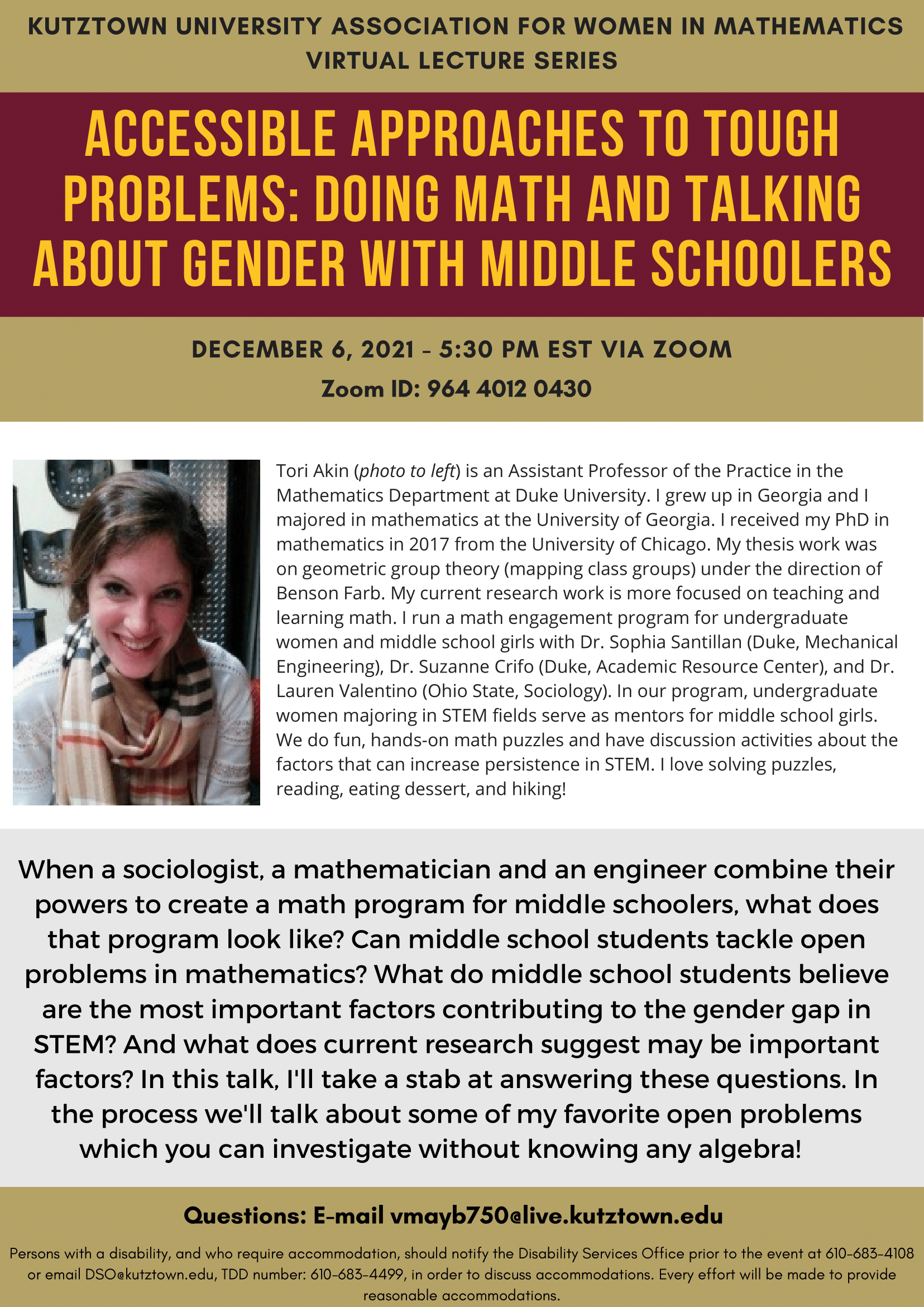
Accessible Approaches to Tough Problems: Doing Math and Talking About Gender with Middle Schoolers
December 6, 2021 at 5:30pm
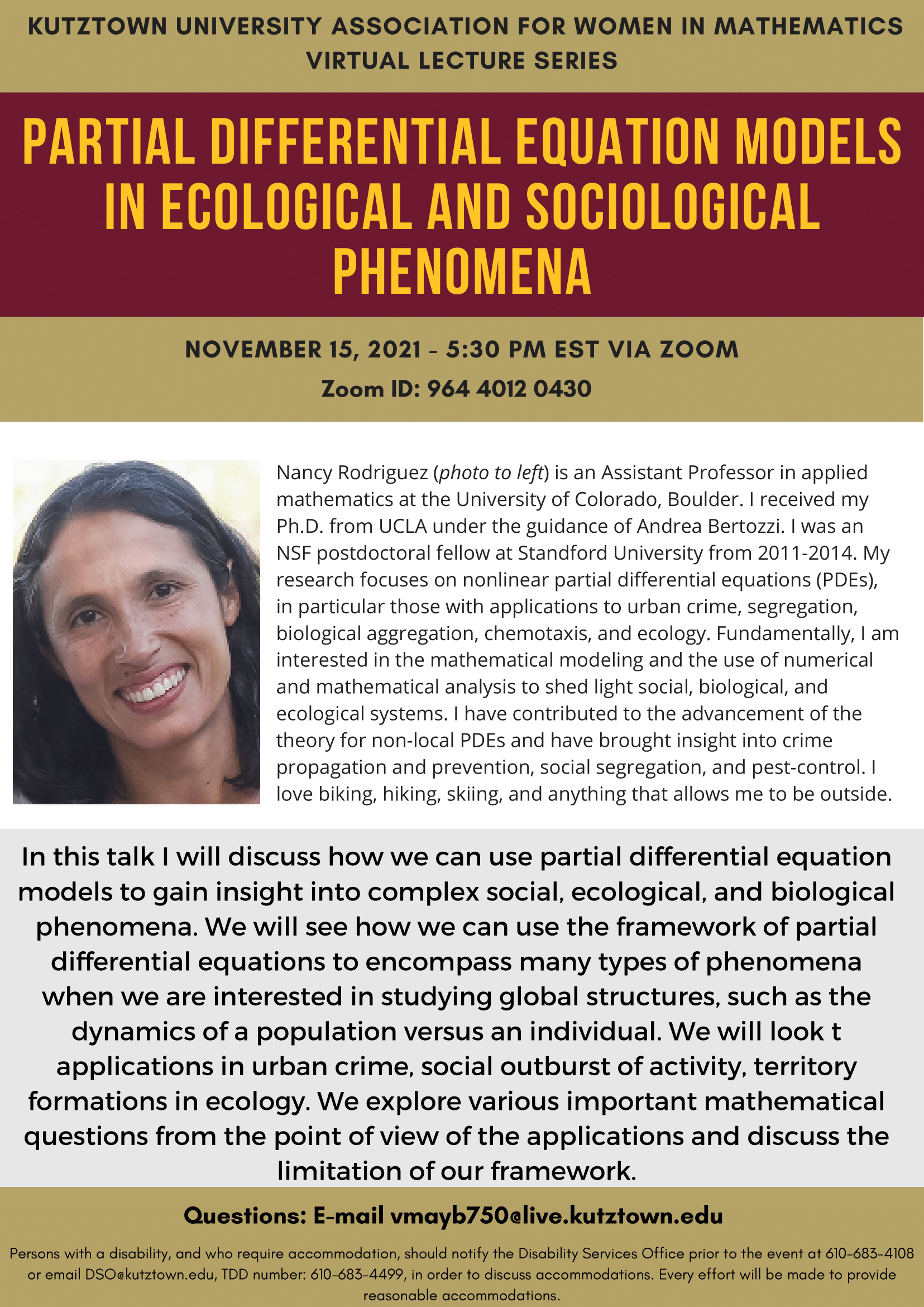
Partial Differential Equation Models in Ecological and Sociological Phenomena
November 15, 2021 at 5:30pm
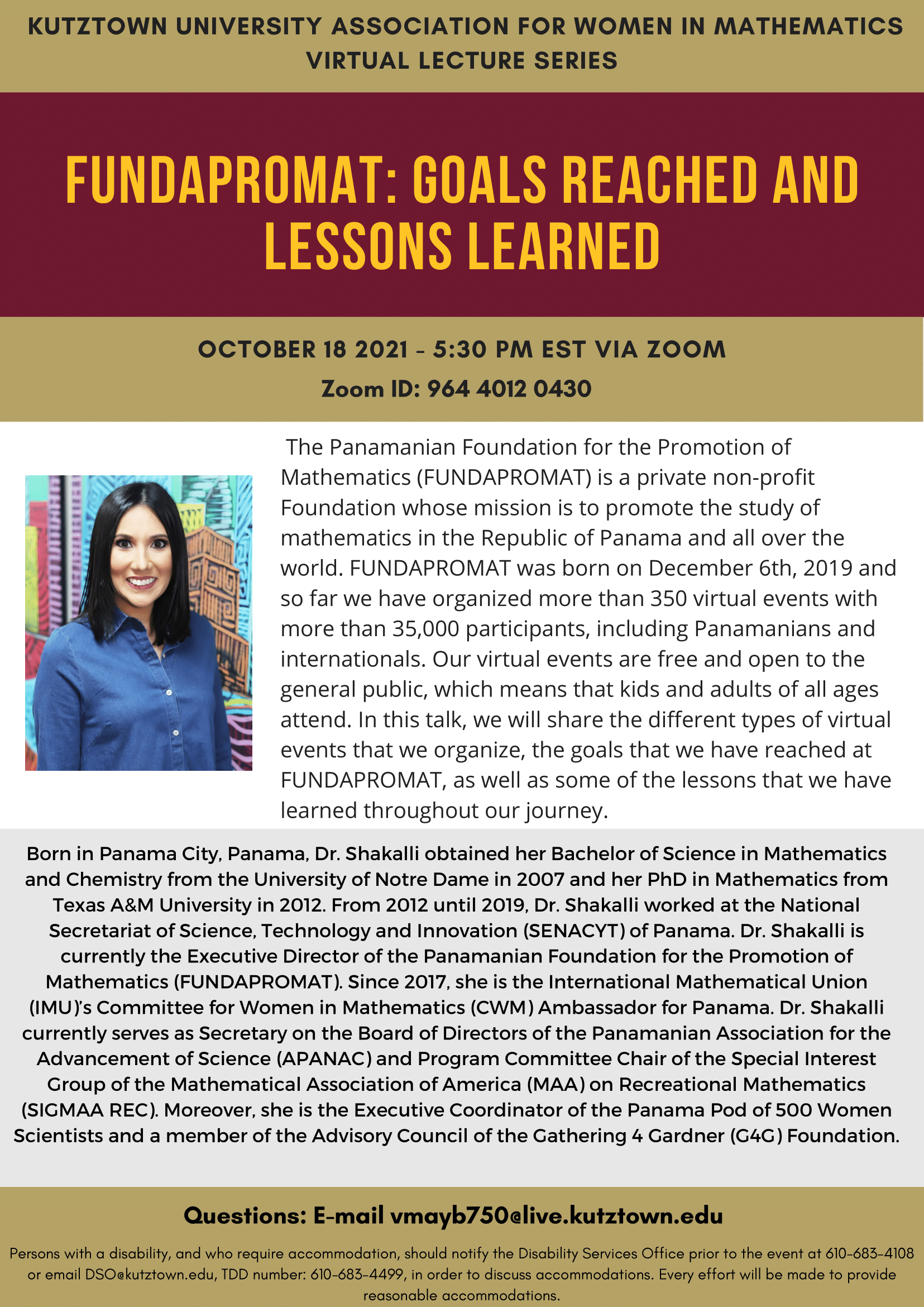
FUNDAPROMAT: Goals Reached and Lessons Learned
October 18, 2021 at 5:30pm
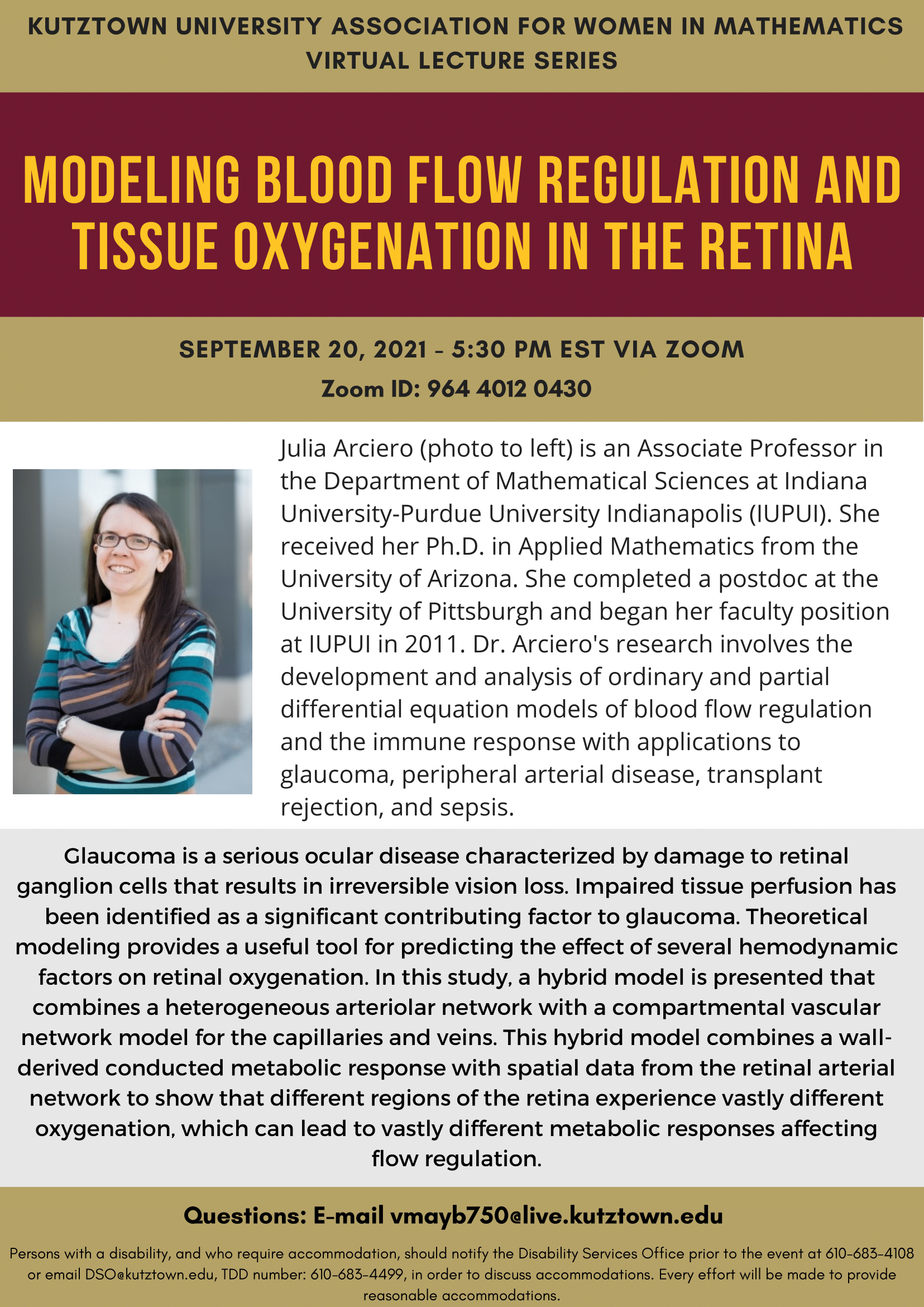
Modeling Blood Flow Regulation and Tissue Oxygenation in the Retina
September 20, 2021 at 5:30pm





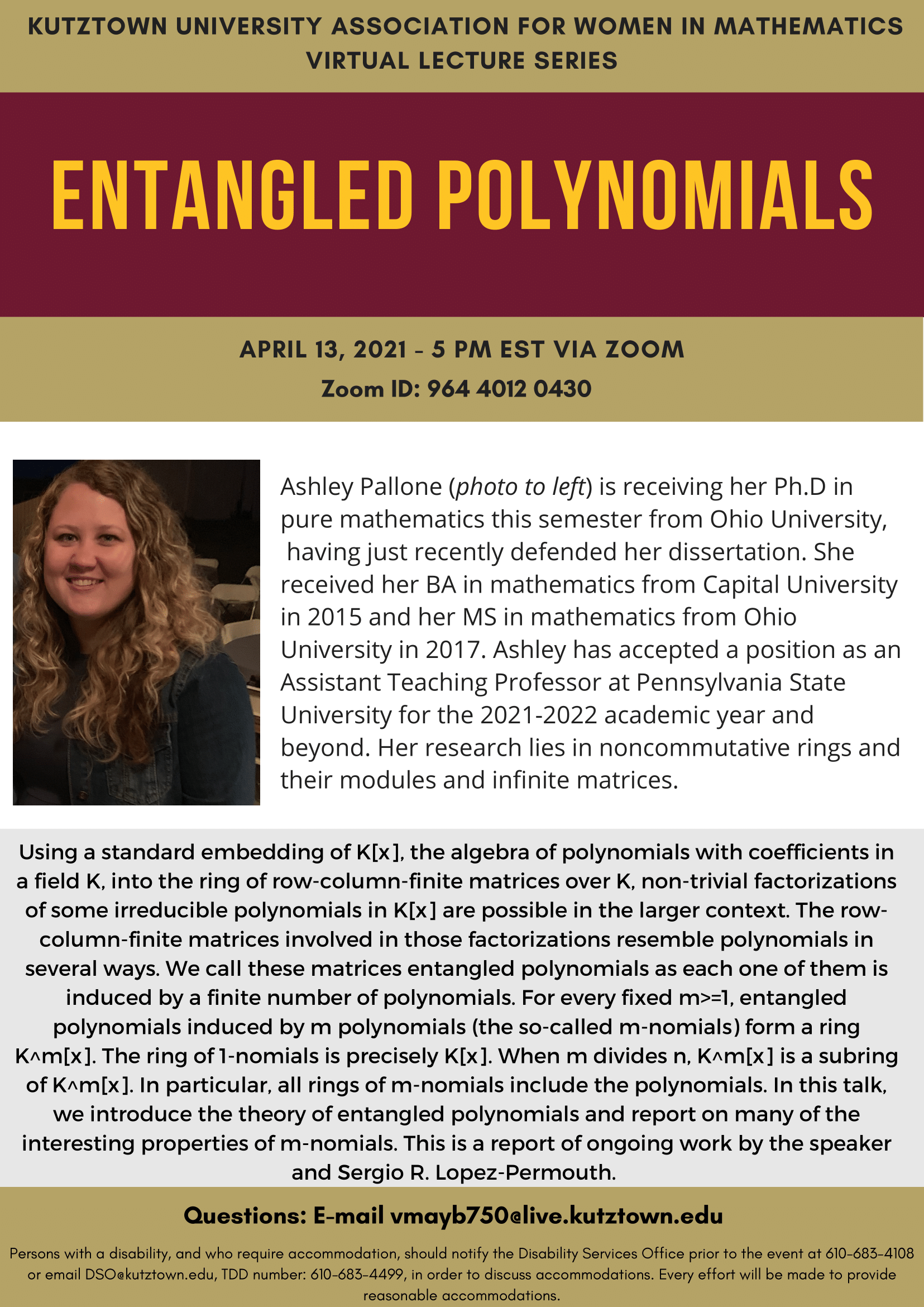
Entangled Polynomials
April 13, 2021 at 5pm
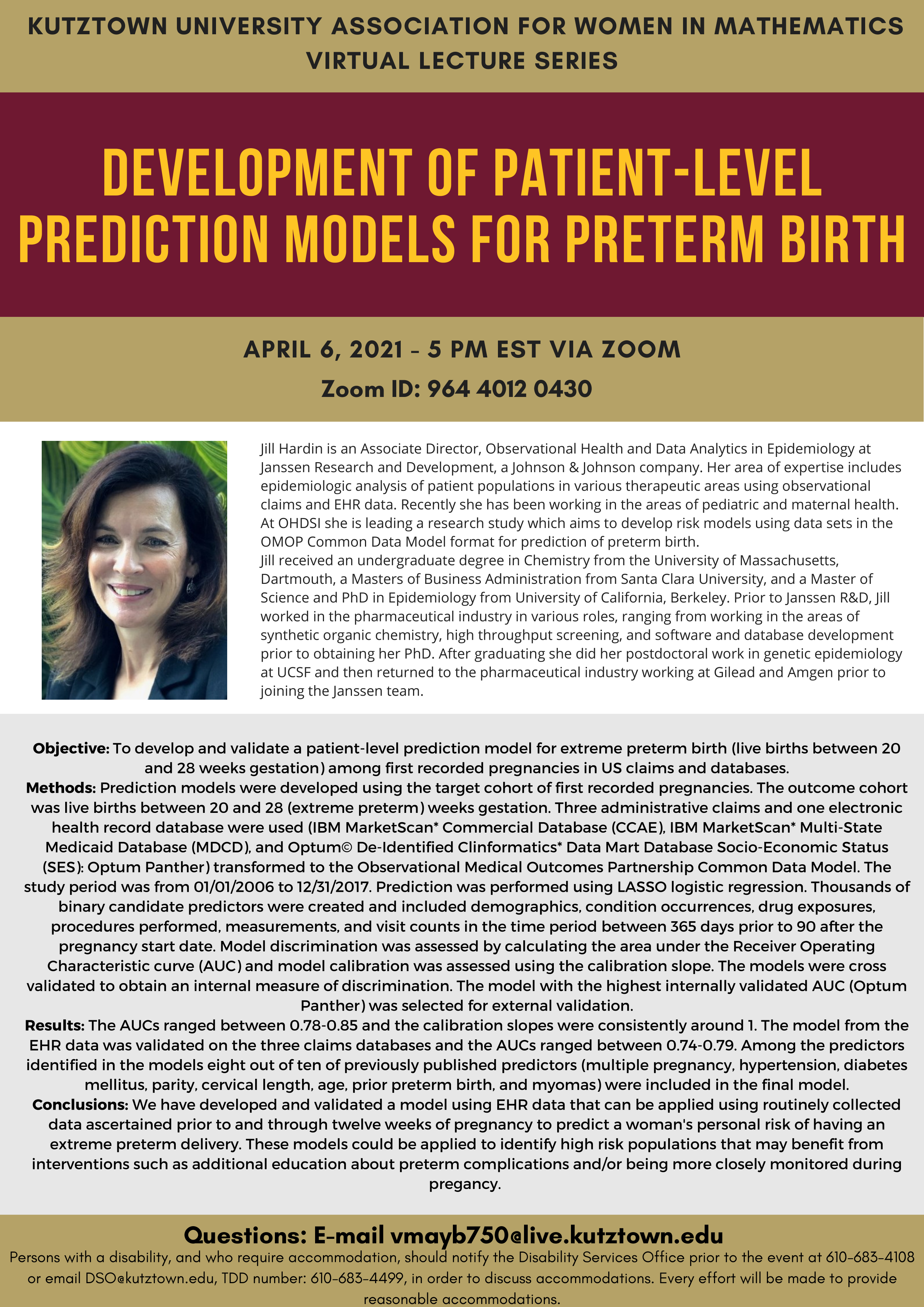
Development of Patient-Level Prediction Models for Preterm Birth
April 6, 2021 at 5pm
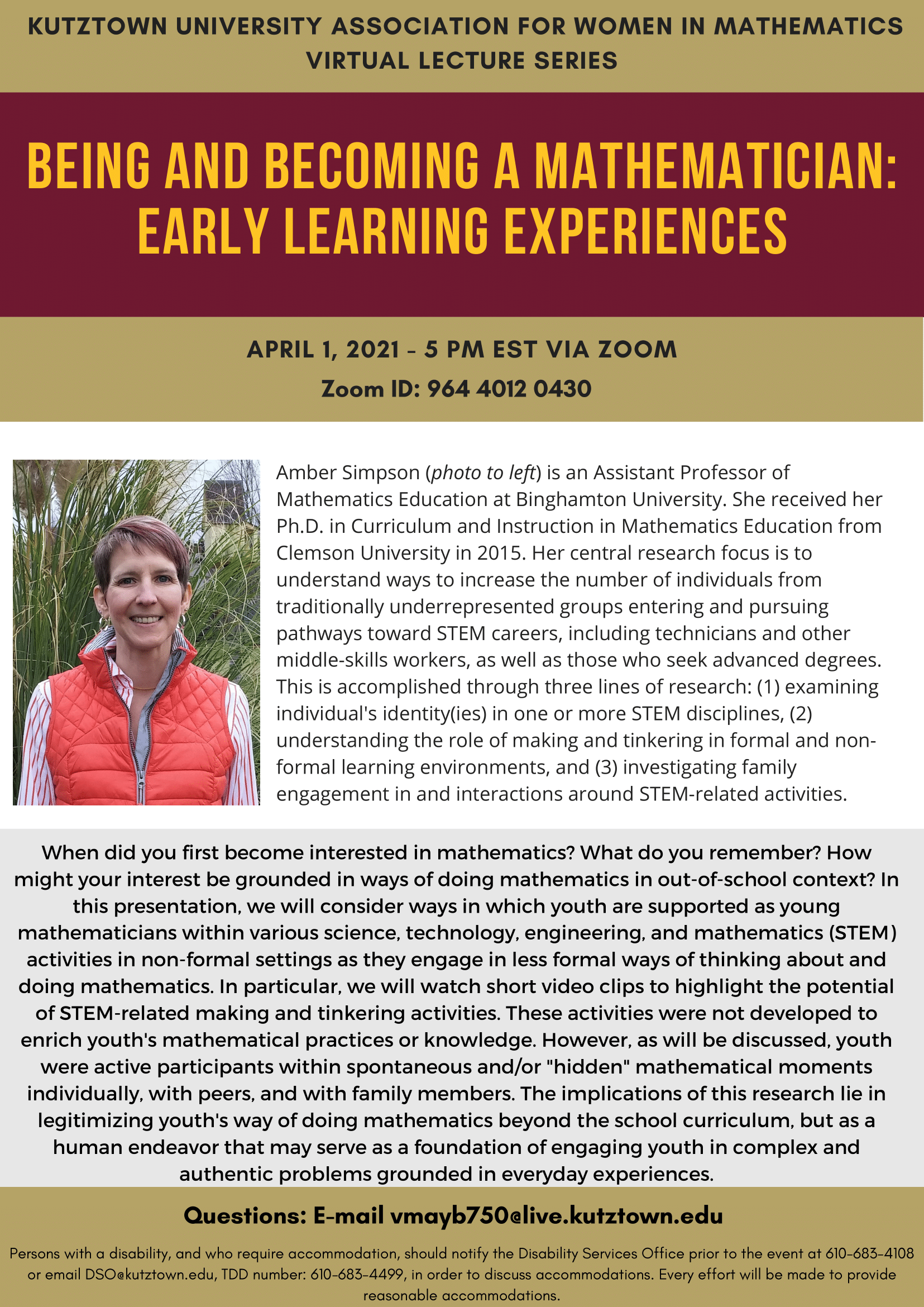
Being and Becoming a Mathematician: Early Learning Experiences
April 1, 2021 at 5pm
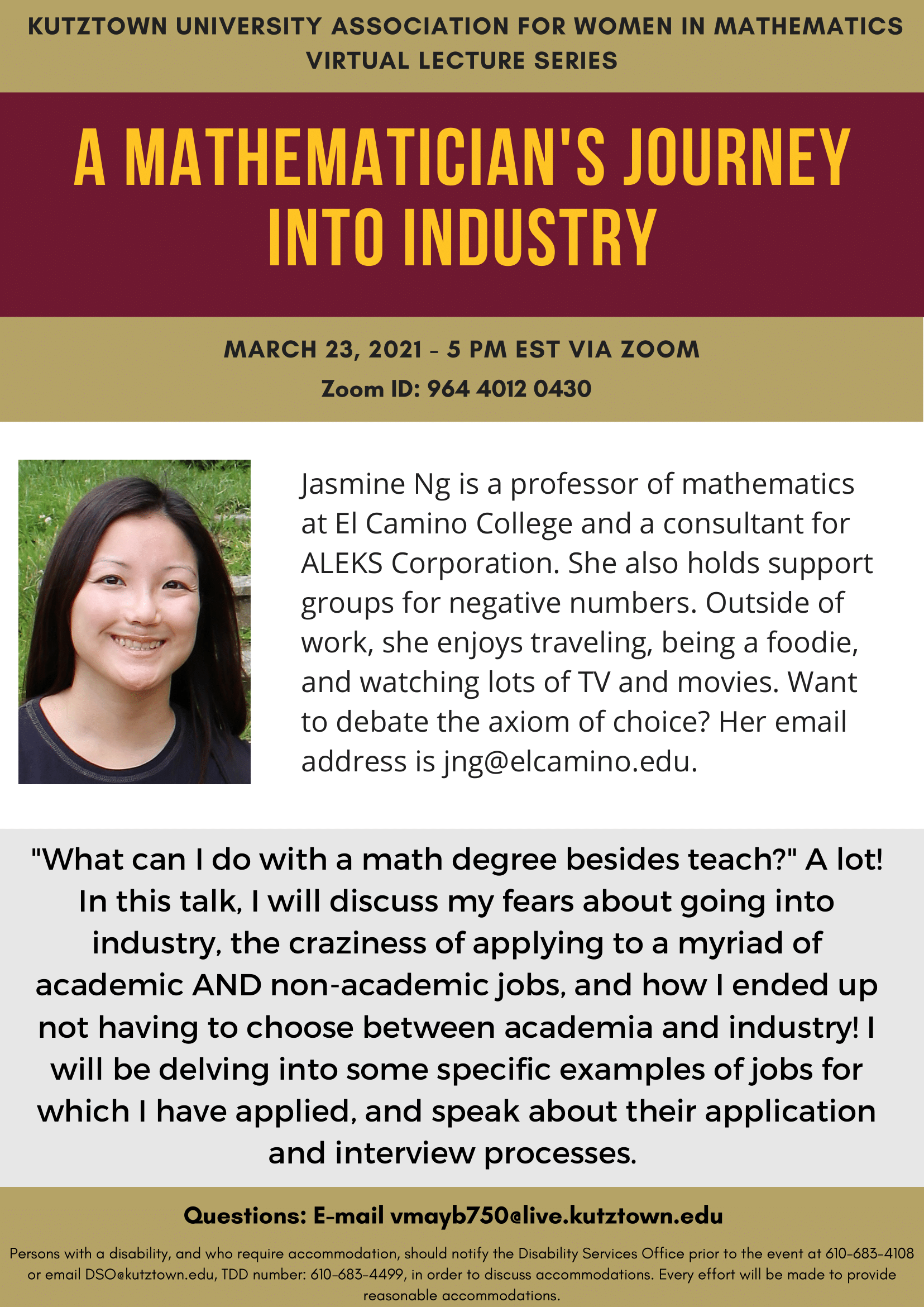
A Mathematician's Journey into Industry
March 23, 2021 at 5pm
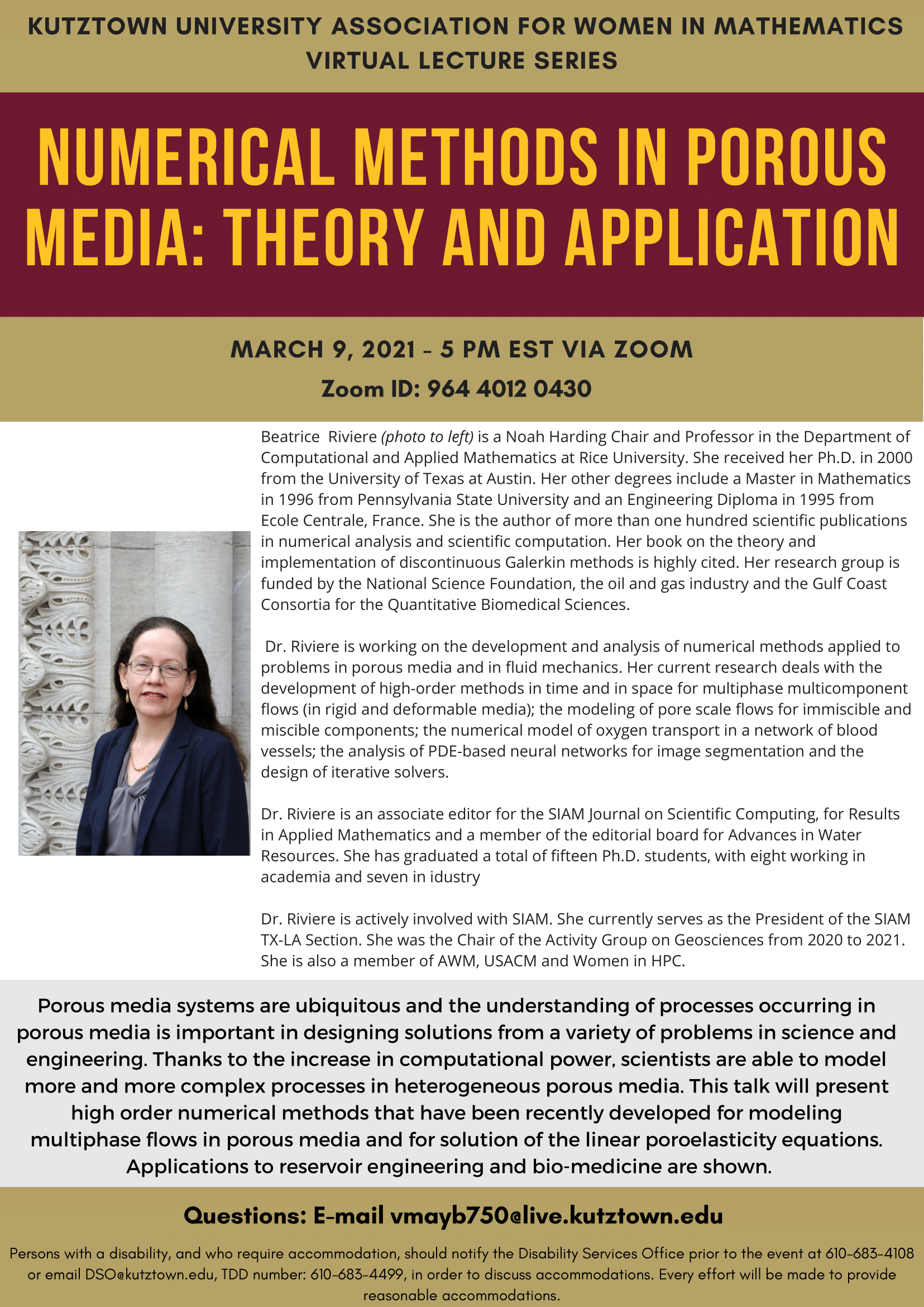
Numerical Methods in Porous Media: Theory and Application
March 9, 2021 at 5pm
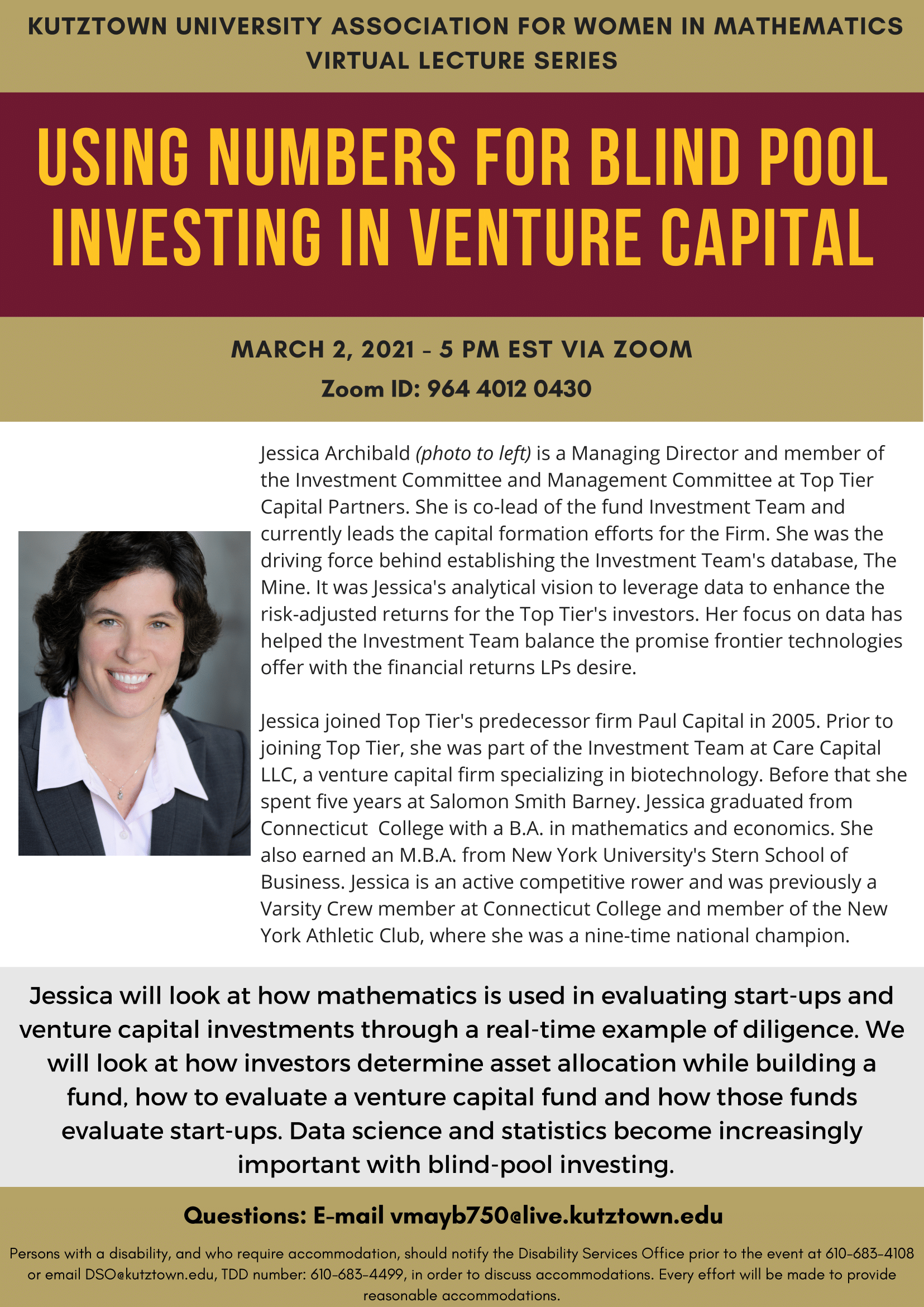
Using Numbers for Blind Pool Investing in Venture Capital
March 2, 2021 at 5pm
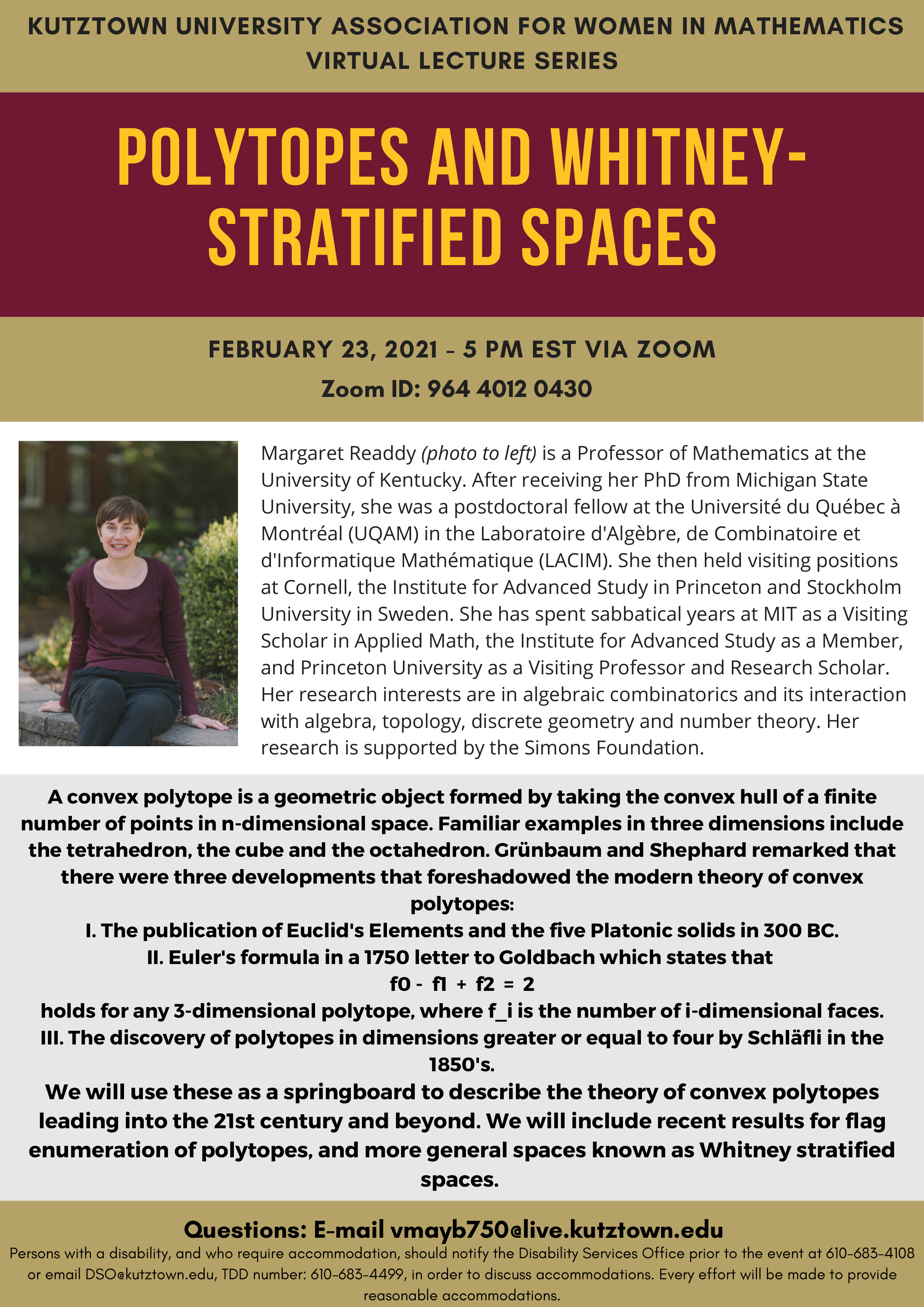
Polytopes and Whitney-Stratified Spaces
February 23, 2021 at 5pm
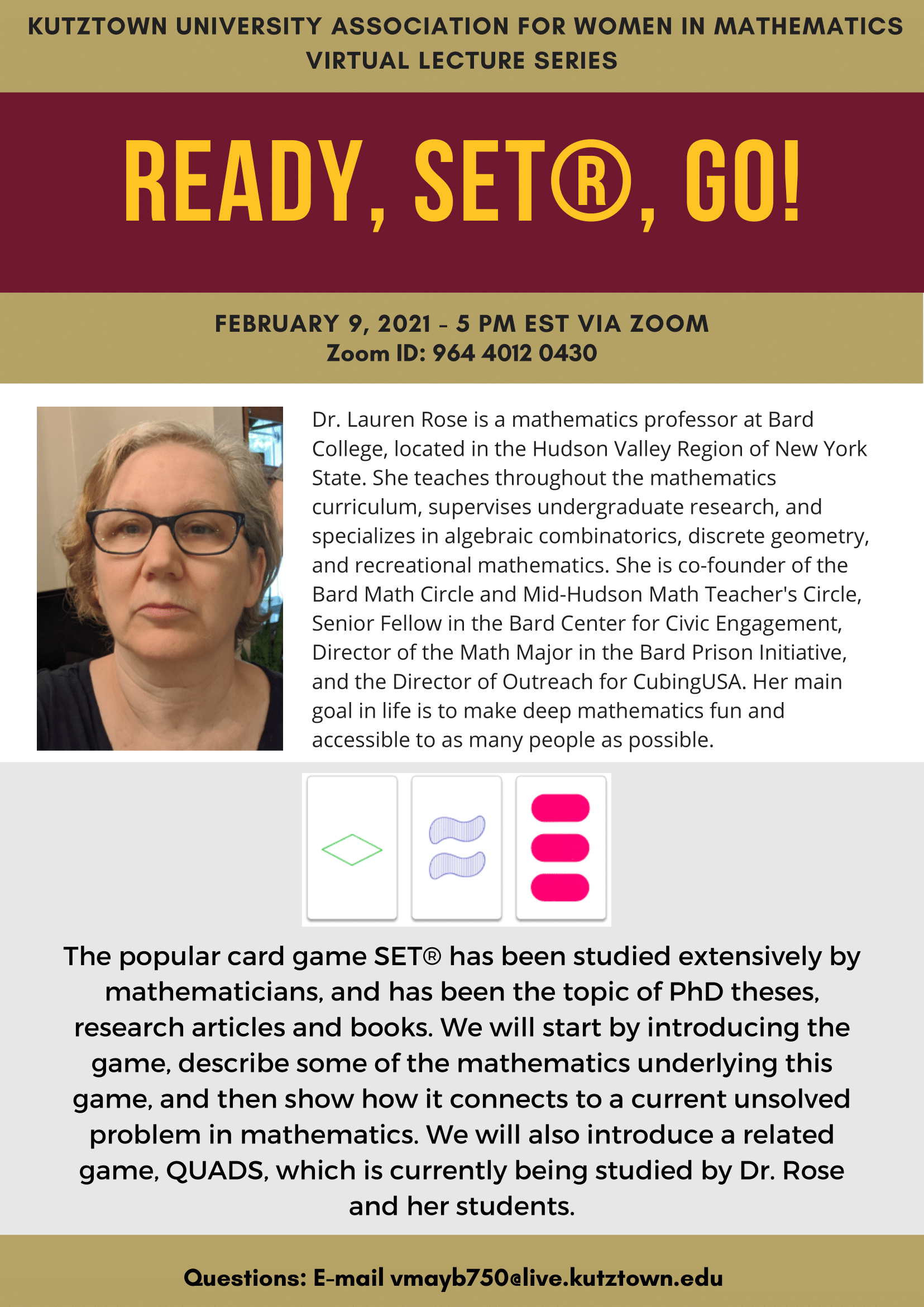
Ready, SET®, Go!
February 9, 2021 at 5pm
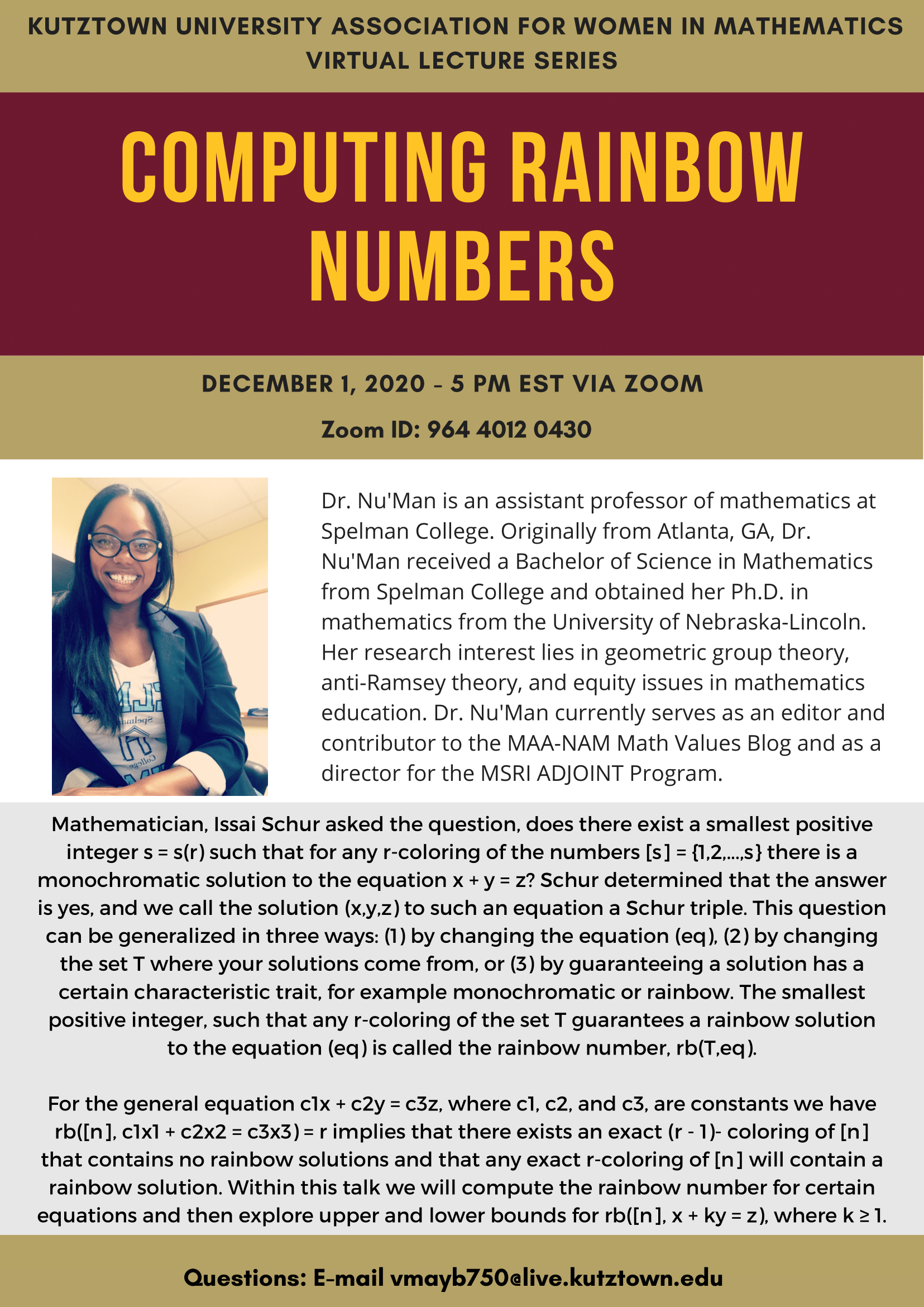
Computing Rainbow Numbers
December 1, 2020 at 5pm
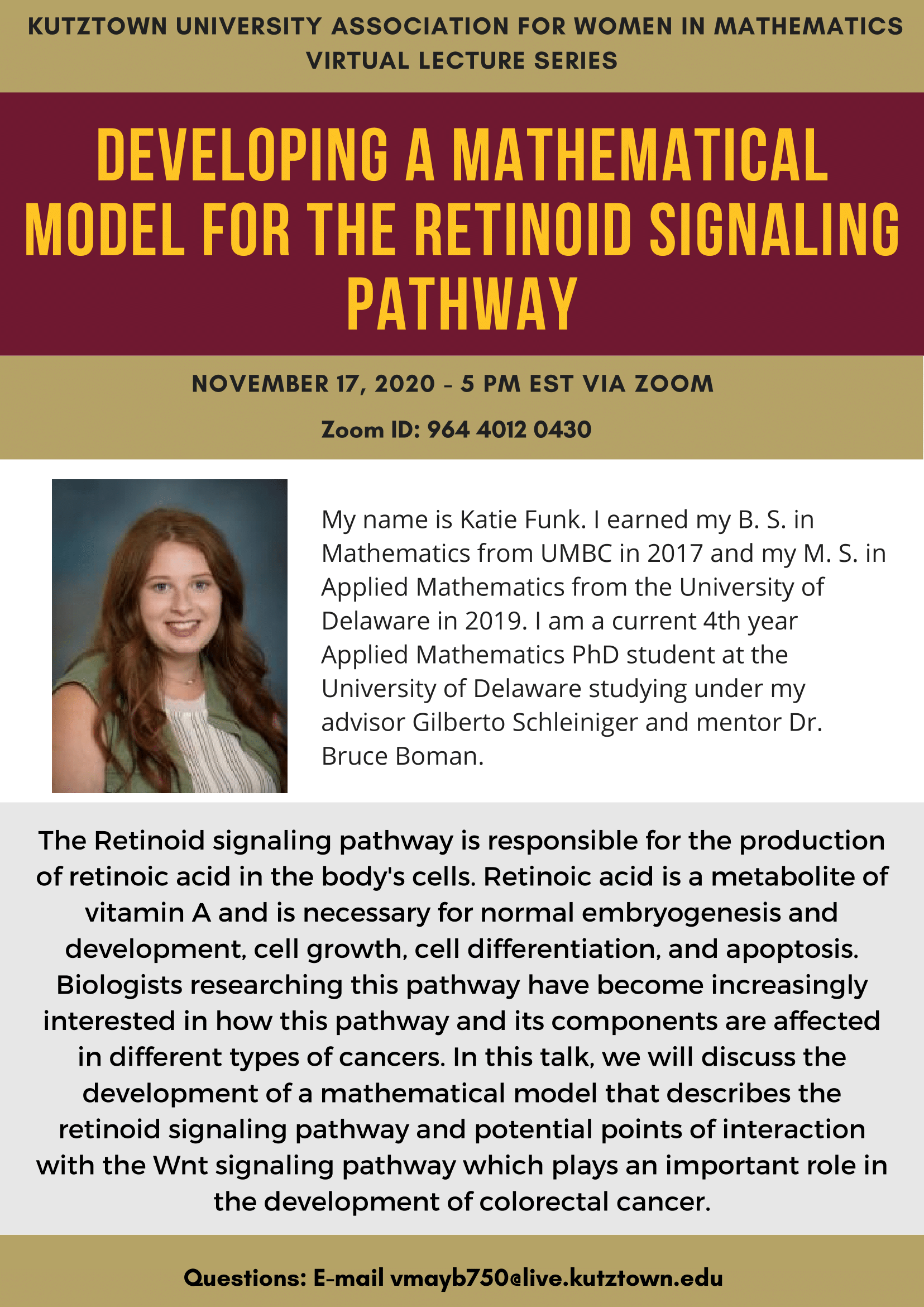
Developing a Mathematical Model for the Retinoid Signaling Pathway
November 17, 2020 at 5pm

Comprehensive Framework For Data-Driven Model Form Discovery of the Closure Laws in Thermal-Hydraulics Codes
November 10, 2020 at 5pm
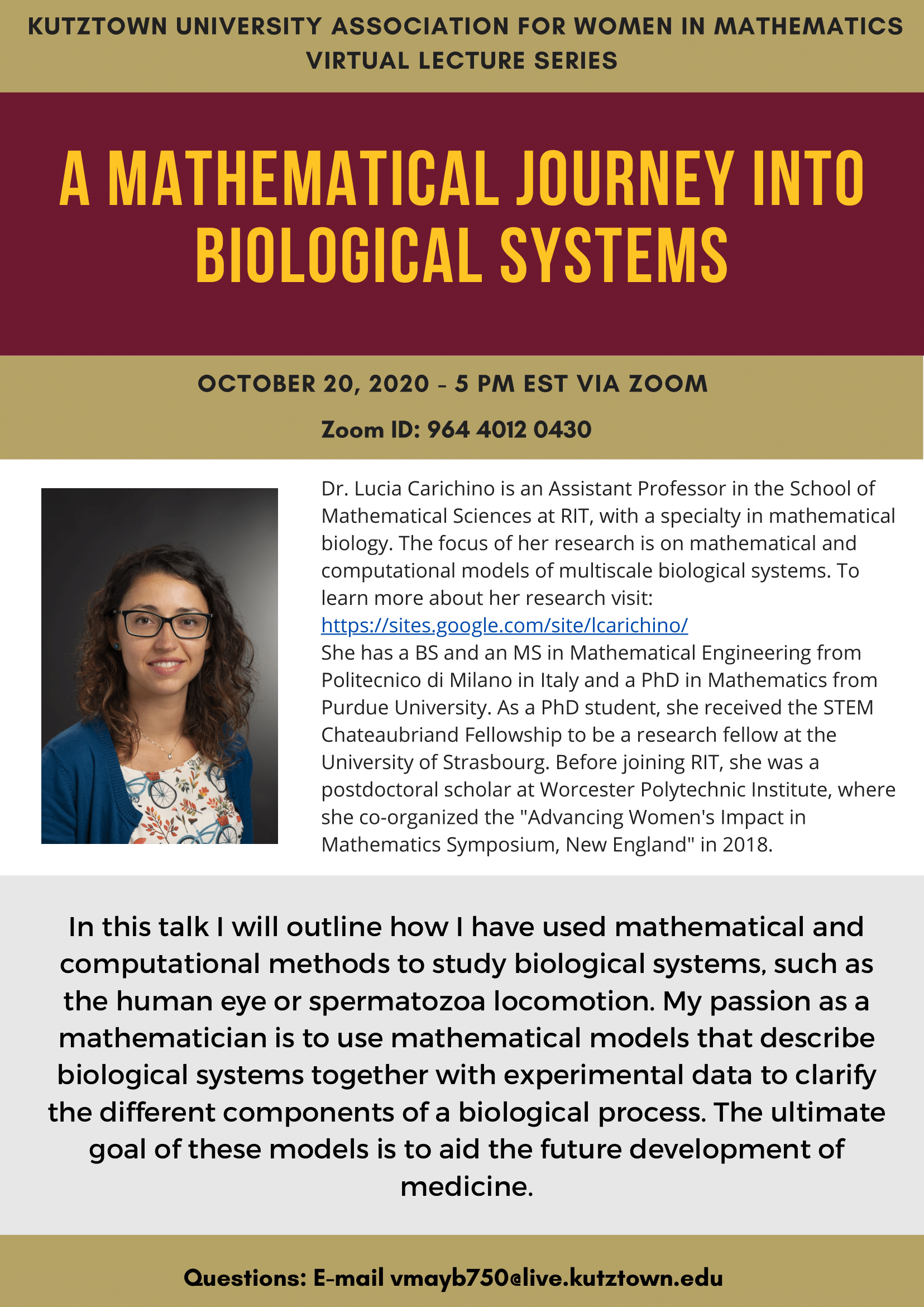
A Mathematical Journey into Biological Systems
October 20, 2020 at 5pm
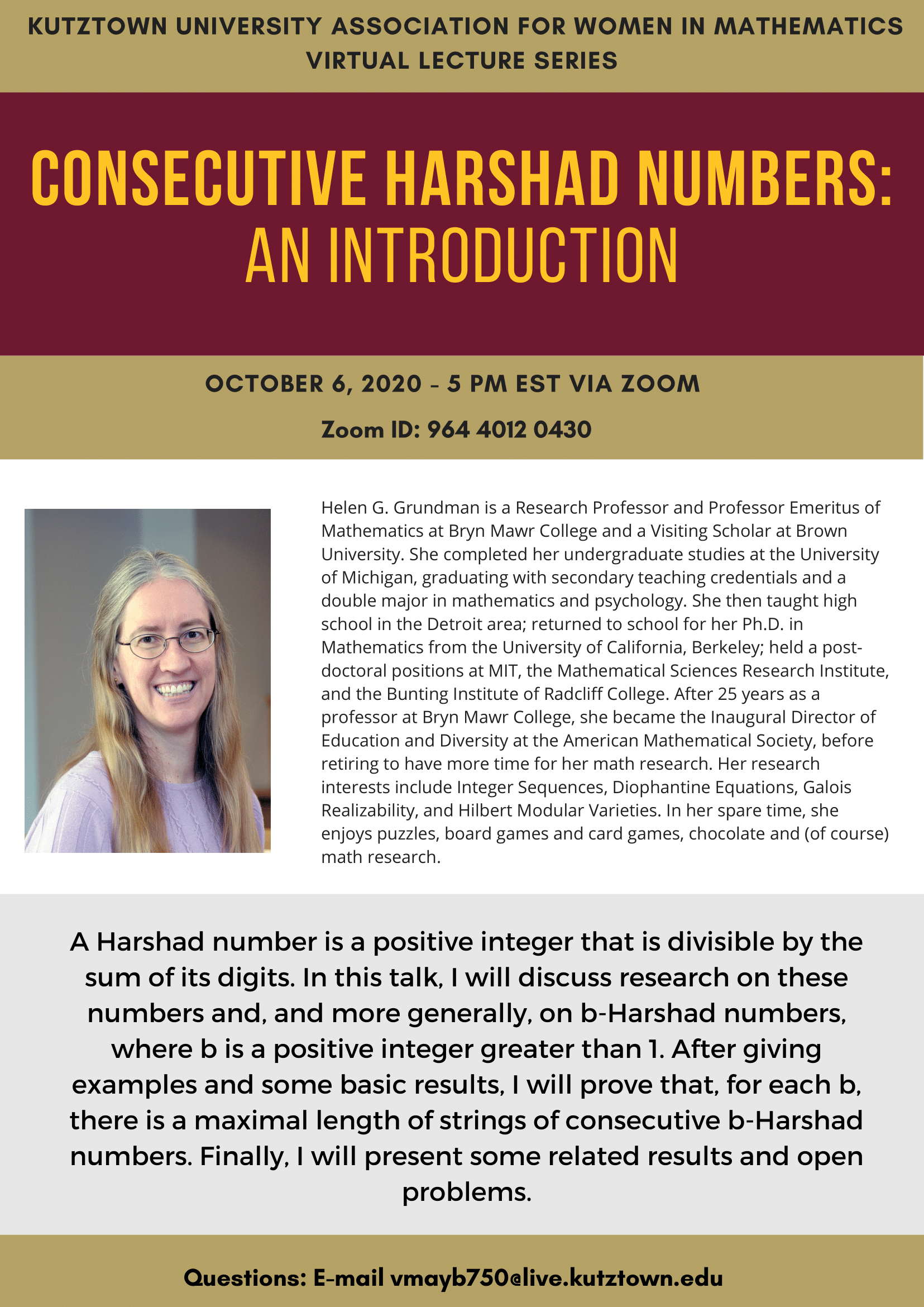
Consecutive Harshad Numbers: An Introduction
October 6, 2020 at 5pm
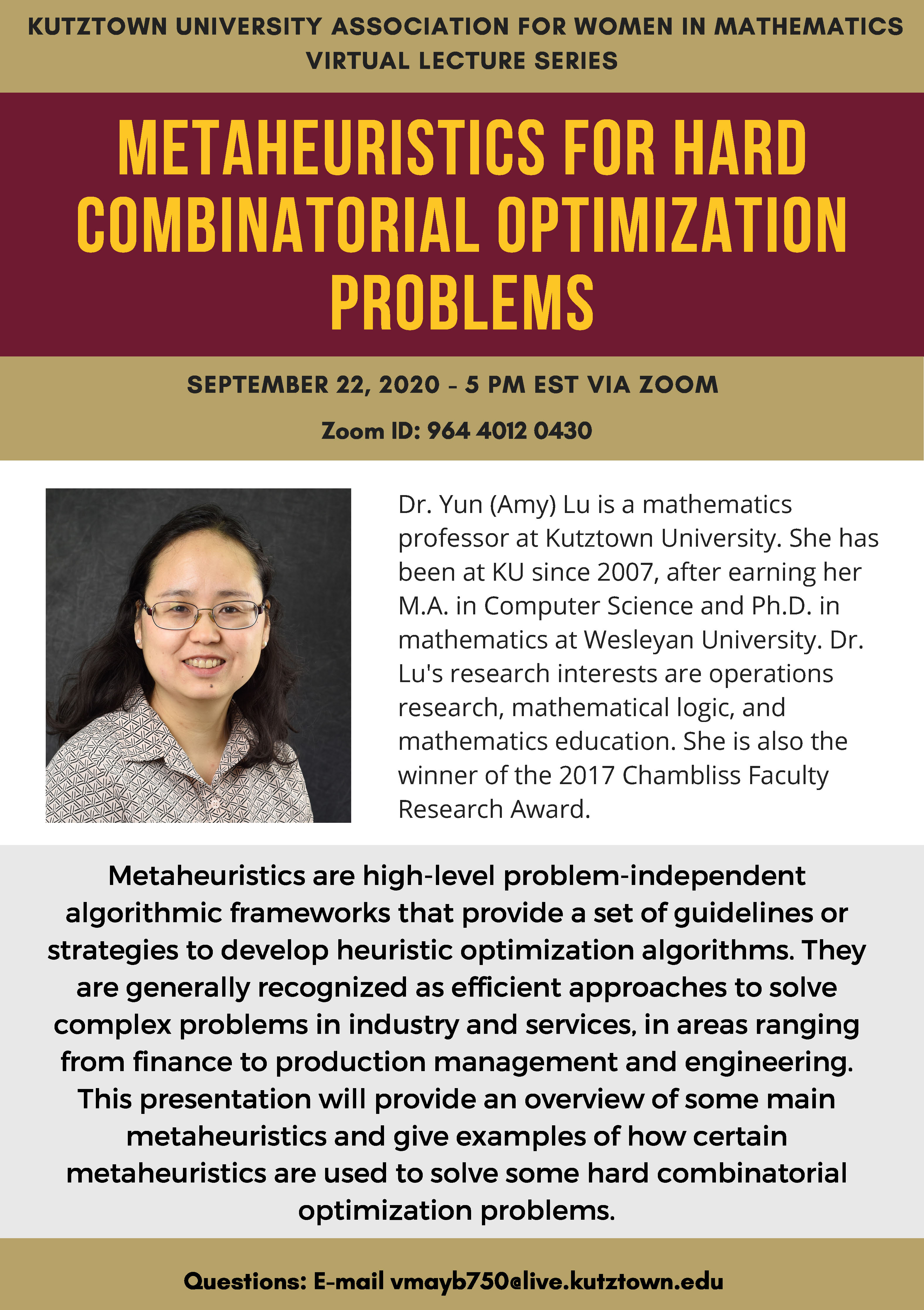
Metaheuristics for Hard Combinatorial Optimization Problems
September 22, 2020 at 5pm














2018-2019
-
Dr. Brooks Emerick: "MPI 2018 - Mathematical modeling of blood flow through the heart"
Friday, October 26 at 3 pm in Lytle 203
Abstract:
Mathematical Problems in Industry is a yearly event that brings together mathematicians and industrial professionals that share a love for practical mathematical problems. Over the course of a week, the industry representatives share a difficult problem with professors and graduate students across the nation, hoping that they may find an answer.This year, one such problem considered the failure of Fontan blood flow circulations of the heart. Fontan is a surgical procedure applied to a malformed heart characterized by the presence of only one functional ventricular chamber.
This talk will focus briefly on an introduction of the mathematical model for Fontan patients with an emphasis on generalizing such models for single and double species systems. Some open questions will also be posted.
-
Dr. Eric Landquist: "How to Create an Elo-Based Sports Ranking and Prediction Model"
Friday, October 5 at 3 pm in Lytle 203
Abstract:There are numerous algorithmic strategies for objectively ranking sports teams and predicting the outcomes of games or competitions. In the 1950s, Arpad Elo created a rating system for professional chess players that has been adapted to various sports and other competitions.
In this talk, we discuss frameworks for modifying Elo's original rating system for application to ranking sports teams. The objective of these frameworks is to maximize the accuracy of the probability of victory implied by the resulting model. One desirable feature of these models is that they can be used to predict the margin of victory of games. One framework applies the Jaya optimization algorithm and does not take the margin of victory into consideration, while a second framework does.
We applied the latter framework to college basketball in order to predict the outcome of the 2018 Men's and Women's NCAA Tournament as part of a Kaggle competition. Although this model correctly picked Villanova to win the Men's Tournament, it did not foresee UMBC defeating UVA in the first round nor Notre Dame winning the Women's Tournament.
-
Dr. Wing Hong Tony Wong: "A disguised random walk problem"
Friday, September 21 at 11 am in Lytle 108
Abstract:
One rainy afternoon, Alice and Bob decided to stay home and play a little game. They took turns to gain 1 point or 2 points each time, decided by tossing a fair coin. The first player who accumulated 100 points would win the game.- Can we determine the winning probability of Alice? Bob?
- What if the game is more complicated?This project is a collaboration with Ms. Jiao Xu, who graduated from Kutztown University in Spring 2017.
-
"Open Problems for Senior Seminar and Undergraduate Research"
Wednesday, September 5 at 11 am in Lytle 136
The faculty has a ton of cool research and project ideas and want to share them!
2017-2018
-
Dr. John Botzum (KU): "The Phi-bonacci Sequence"
Friday, April 27 at 3 pm in Lytle 203
Abstract:
Sometimes innocent questions from students can stir long-forgotten memories and stimulate mathematical investigation.
Last year I took over my wife’s Discrete Mathematics course for a week. I spent much of the first class working out elementary induction proofs and introducing recurrence relations. At the end of the class one of the students asked if there was a recurrence relation for the nth term of the Fibonacci sequence. I was in a hurry to teach a class 45 minutes away so I foolishly replied that I did not think there was. On the drive to my other job I recalled Binet’s formula which prompted me to dig up notes on this subject that I had long since forgotten. This paper will discuss my discovery and re-discovery of the beautiful interplay between Binet’s recurrence relation, the Golden Mean, and the Fibonacci Sequence as well as discuss whether Binet was the first to discover the formula.
-
Dr. Brian Kronenthal (KU): "Algebraically Defined Graphs in Two and Three Dimensions"
Friday, April 20 at 3 pm in Lytle 203
Abstract:
In this talk, we will discuss algebraically defined bipartite graphs. Indeed, let F denote a field, and consider the bipartite graph whose partite sets P and L are copies of F3 such that (p1, p2, p3) ∈ P and [f1, f2, f3] ∈ L are adjacent if and only if p2 + f2 = p1f1 and p3 + f3 = p1f2. This graph has girth eight, and of particular interest is whether it is possible to alter these equations by replacing p1f1 and p1f2 with other bivariate polynomials to create a nonisomorphic girth eight graphs. In addition to discussing some results related to this question, as well as a two-dimensional analog, we will also explain the connection between algebraically defined graphs and incidence geometry, which partially motivates this line of inquiry. -
Dr. Jian Cheng (University of Delaware): "Signed Graphs: Flows and Embeddings"
Friday, March 23 at 3 pm in Lytle 203
Abstract:
A signed graph $(G,\sigma)$ is a graph $G$ together with a sign $\sigma: E(G)\to\{\pm1\}$. An edge is positive if it is assigned with $1$ and otherwise it is negative. In 1983, Bouchet generalized the concept of integer flows to signed graphs and conjectured that every flow-admissible signed graph admits a nowhere-zero $6$-flow. Let $G$ be a graph embedded on a nonorientable surface $\Sigma$. Denote by $\sigma_{\Sigma}$ an induced sign of $G$ from its embedding on $\Sigma$, where an edge is negative if and only if it passes through a crosscap. It is well known that every graph embedded on the projective plane or Klein bottle is $6$-colorable. By the coloring-flow duality, every such graph satisfies Bouchet's $6$-flow conjecture. In this talk, more results and open problems regarding flows on embedded graphs will be presented and investigated. -
Dr. Eric Landquist (KU): "A Card Trick, A Microsoft Interview Question, and Discrete Logarithm Problems"
Friday, December 1 at 3 pm in Lytle 203
Abstract:
This talk will be a warm-up to talks I'll give after returning from a sabbatical that covers various aspects of cryptography. We'll start with a fun little card trick that will motivate the concept behind an algorithm called Pollard's Kangaroo Algorithm.To that end, we'll cover the Discrete Logarithm Problem (DLP), elliptic curves, the Elliptic Curve DLP (ECDLP), Pollard's Rho method to compute discrete logarithms, and then the Kangaroo algorithm. The Microsoft interview question relates to a tangential application of Pollard's Rho method to software engineering and detecting infinite loops.
-
Dr. Eric Landquist (KU): "A Card Trick, A Microsoft Interview Question, and Discrete Logarithm Problems"
Friday, December 1 at 3 pm in Lytle 203
Abstract:
This talk will be a warm-up to talks I'll give after returning from a sabbatical that covers various aspects of cryptography. We'll start with a fun little card trick that will motivate the concept behind an algorithm called Pollard's Kangaroo Algorithm.To that end, we'll cover the Discrete Logarithm Problem (DLP), elliptic curves, the Elliptic Curve DLP (ECDLP), Pollard's Rho method to compute discrete logarithms, and then the Kangaroo algorithm. The Microsoft interview question relates to a tangential application of Pollard's Rho method to software engineering and detecting infinite loops.
-
Dr. Ju Zhou (KU): "Induced Matching Extendable Graphs"
Friday, November 17 at 3 pm in Lytle 203
Abstract:
A graph G is induced matching extendable or IM-extendable if every induced matching of G is contained in a perfect matching of G. Since the definition was proposed, a lot of research has been done in this area. In 1998, Yuan proved that a connected IM-extendable graph on 2n vertices has at least 3n-2 edges, and that the only IM-extendable graph with 2n vertices and 3n-2 edges is T x K_2, where T is an arbitrary tree on n vertices.In 2005, Zhou and Yuan proved that the only IM-extendable graph with 2n≥ 6 vertices and 3n-1 edges is T x K_2+e, where T is an arbitrary tree on n vertices and e is an edge connecting two vertices that lie in different copies of T and have distance 3 between them in T x K_2. In this talk, I will introduce the definition of Q-joint graph and characterize the connected IM-extendable graphs with 2n ≥ 4 vertices and 3n edges.
-
Mr. Grant Fickes (KU Math Major): "Edge-Distinguishing Chromatic Number"
Friday, November 10 at 3 pm in Lytle 203
Abstract:
Let G denote a simple graph consisting of vertices and edges, where each edge connects two distinct vertices. When we color the vertices of G, each edge will then be labeled by the colors of the two vertices it connects.For example, if an edge connects a red vertex and a blue vertex, then this edge is labeled by {red, blue}. We call the coloring of G “edge-distinguishing” if all the edge labels are distinct, and the minimum number of colors that we need to create an edge-distinguishing coloring is called the “edge-distinguishing chromatic number” (EDCN) of G.
In previous literature by Al-Wahabi et al., the EDCN was found when G was a path and a cycle. In this presentation, I will expand their ideas to find the EDCN when G is a spider graph.
-
Dr. Fran Vasko (KU): "The No Free Lunch Theorem and Bin Packing"
Friday, October 27 at 3pm in Lytle 203
-
Dr. Eric Landquist (KU): "Making Complexity Theory Less Complex"
Friday, October 20 at 3 pm in Lytle 203
Abstract:
- What are P, NP, NP-complete, and NP-hard, and the P vs NP problem?- Why should we care?
- How is a German researcher trying to win a million dollars?
All this and more!
-
Dr. Ju Zhou (KU): "Perfect Matching Transitive Graphs"
Friday, September 29 at 3 pm in Lytle 203
Abstract:
An automorphism of a graph G = (V(G),E(G)) is a permutation f of the vertex set V(G), such that the pair of vertices (u,v) form an edge if and only if the pair (f(u),f(v)) also form an edge. A perfect matching transitive graph is a graph such that for any two perfect matchings M and N of G, there exists an automorphism of G such that f(M)=N.- What kinds of graphs are perfect matching transitive?
- What is the relationship between perfect matching transitive and vertex transitive?
- What is the relationship between perfect matching transitive transitive and edge transitive?
In this talk, the author will talk about some preliminary research about perfect matching transitive graphs.
-
Dr. Brooks Emerick (KU): "Discrete Host-Parasitoid Modeling with a pinch of Continuity and dash of Graph Theory "
Friday, September 15 at 3 pm in Lytle 203
Abstract:
Extensive work has been done on analyzing host-parasitoid interactions using discrete-time models, the most notable of which is the Nicholson-Bailey model.Our research focuses on a semi-discrete framework in which the host-parasitoid interactions are characterized by a continuous-time model. The continuous dynamic allows us to incorporate intricate behaviors of the host-parasitoid interaction such as host-feeing, egg load capacity, or migration.
This talk will focus on the migration of parasitoids between two locations. We find that in the simplest case, when the migration rates are constant, the model is unstable yielding diverging oscillations similar to the Nicholson-Bailey model. However, when we consider one-way migration, i.e. a no-return scenario, coexistence between hosts and parasitoids occurs. A similar stability region arises when we consider an instant transportation of parasitoids between the two locations.
We will discuss the idea of a weighted graph that represents a general network of host-parasitoid locations and formulate a model that represents this scenario. The goal will be to determine what properties of the graph yield stable equilibria.
-
Open problem session
Friday, September 8 at 3pm in Lytle 203
-
Organizational meeting
Friday, September 1 at 3pm in Lytle 203
2016-2017
-
Dr. Janet Fierson & Mr. Eric Frazier (La Salle University): "An interdisciplinary investigation of coloring graphs"
Thursday, May 4, at 3 pm in Lytle 203
Abstract:
Working in the area of chromatic graph theory, we introduce the concept of the coloring graph and share discoveries about its properties. Originally applied to vertex coloring and edge coloring only, this idea has recently been applied to rainbow connection, another relatively new topic.We provide details of our findings, with a particular emphasis on the usefulness of incorporating computer programming into the research process.
-
Ms. Amanda Lohss (Drexel University Ph.D. Candidate): "Tableaux and the Asymmetric Simple Exclusion Process (ASEP)"
Friday, April 28, at 11 am in Lytle 203
Abstract:
Combinatorics is an amazing area of mathematics in which seemly simple objects are surprisingly rich in applications. Tableaux are such combinatorical objects which are as simple to define as the rules for Sudoku (and actually quite similar).Several variations of tableaux have recently been introduced due to connections with an important particle model, the Asymmetric Simple Exclusion Process (ASEP), which has been said to be the default model for transport phenomenon and is used extensively in physics, biology, and biochemistry.
This connection allows various questions about the ASEP to be translated in terms of tableaux and proven in a mathematically elegant way. This talk will discuss the surprising relationship between tableaux and the ASEP as well as some results on tableaux which solve previous conjectures significant in terms of the ASEP.
-
Dr. Brittany Shelton (Albright College): "On God's Number(s) for Rubik's Slide"
Thursday, April 6, at 3 pm in Lytle 203
Abstract:
Rubik's Slide is a puzzle which consists of a 3 x 3 grid of squares that is reminiscent of a face of the well-known cube. Each square may be lit one of two colors or remain unlit. The goal is to use a series of moves, which we view as permutations, to change a given initial arrangement to a given final arrangement. Each play of the game has different initial and final arrangements. To examine the puzzle, we use a simpler 2 x 2 version of the puzzle to introduce a graph-theoretic approach, which views the set of all possible puzzle positions as the vertices of a (Cayley) graph. For the easy setting of the puzzle, the size of the graph depends on the initial coloring of the grid. We determine the size of the graph for all possible arrangements of play and determine the associated god's number (the most moves needed to solve the puzzle from any arrangement in the graph).
We provide a Hamiltonian path through the graph of all puzzle arrangements that describes a sequence of moves that will solve the easy puzzle for any initial and final arrangements. Further, we use a computer program to determine an upper bound for god's number associated to the graph representing the medium and hard versions of the puzzle. This is joint work with Michael A. Jones, Mathematical Reviews, Ann Arbor MI and Miriam Weaverdyck, Bethel College, North Newton KS.
-
Dr. James Hammer (Cedar Crest College): "Embedding Complete Multipartite Graphs into Smallest Dimension"
Friday, March 31 at 3 pm in Lytle 203
Abstract:
For a finite, simple graph G, define G to be of dimension d if d is the minimum value such that G can be drawn with vertices being points of R_d, where adjacent vertices are necessarily placed a unit distance apart.
We determine the dimension of all complete multipartite graphs. Letting G be a complete multipartite graph with n parts, m of which have size one or two, our main result is that G is of dimension 2n - m - 1 when all parts or all but one part of G has size one, and G is of dimension 2n - m otherwise.
-
Ms. Shannon Golden (KU Math Major): "Coloring the Integers"
Thursday, March 23 at 11 am in Lytle 136
Abstract:
We will assign each natural number to be one of two colors (RED or BLUE). The condition is that when the equation x+y=z is monochromatic, meaning that x, y, and z are all the same color, we stop. By generalizing the equation with a coefficient w to (w)x+y=z, we will explore a theorem for the color assignments that allow us to color the most numbers.
In the second part of the talk, we will turn this coloring into a two-person game. Starting at 1, players alternate assigning colors. In order to win, the opponent must not be able to assign their number to be either color.
-
Dr. Ferdinand Ihringer (University of Regina): "Intriguing Sets in Quadrangles, Hexagons and Octagons"
Tuesday, March 7 at 4:30pm in Lytle 203
Abstract:
A generalized quadrangle (GQ) of order (s;t) consists of a set of points P and a set of lines L such that each line contains exactly s+1 points and each point lies in exactly t+1 lines. The point graph of a GQ is strongly regular. We limit ourselves to classical GQs, which are closely related to orthogonal, symplectic and unitary groups.
In the first part of the talk, we will discuss bounds for the independence number of the point graphs of GQs. In the second part, we will present some results on the existence of intriguing sets, a natural generalization of Delsartes cliques and Delsartes cocliques, in GQs. In the third part, we will present similar results for generalized hexagons and generalized octagons.
-
Dr. Barry Smith (Lebanon Valley College): "Necklace invariants: tools for analyzing class groups"
Thursday, March 2 at 3 pm in Lytle 203
Abstract:
Gauss created a binary operation on classes of binary quadratic forms, and through a computational 𝑡𝑜𝑢𝑟 𝑑𝑒 𝑓𝑜𝑟𝑐𝑒, he showed that the classes form an abelian group. Class groups have dominated the field of algebraic number theory ever since. I will describe how to attach combinatorial necklaces to classes of indefinite binary quadratic forms and how to use these necklace invariants to obtain results about class groups. -
Dr. Joshua Harrington (Cedar Crest College): "Fields Containing Consecutive Elements of Order n"
Friday, February 17 at 11 am in Lytle 203
Abstract:
Given a positive integer n, we study conditions under which a finite field of prime order will contain consecutive elements of order n. A curious connection to the Lucas Numbers and Mersenne numbers will be discussed. -
Dr. Brian Kronenthal: "REUs and ADGs"
Friday, February 5 at 11 am in Lytle 203
Abstract:
Undergraduates can do research in math, and you don’t even have to be a junior or senior. In fact, some research programs specifically target students who are just finishing their freshman or sophomore years.In this talk, I will briefly describe the National Science Foundation’s Research Experiences for Undergraduates (REU) program, as well as explain an REU project that I will be supervising this summer at Lafayette College on Algebraically Defined Graphs (ADGs).
I encourage any interested Kutztown students to apply for this project (especially students who have taken Abstract Algebra or Number Theory), as well as other REU programs of interest.
-
Organizational meeting
Friday, January 27 at 11 am in Lytle 203
-
Mr. Zach Kern (KU Math Major): "An empirical analysis of three population-based metaheuristics for solving the multidimensional knapsack problem"
Friday, November 11 at 3 pm in Lytle 136
Abstract:
The Multidimensional Knapsack Problem (MKP) is a computationally complex (NP-hard) combinatorial optimization problem with many real-world applications. In this study, we adapt two relatively new metaheuristics designed originally to solve continuous nonlinear problems to solve the binary Multidimensional Knapsack Problem.Specifically, we adapt the two-phase Teaching-Learning Based Optimization (TLBO) approach developed by Rao, Savsani, and Vakharia (2011) and the recently introduced metaheuristic JAYA by Rao (2016) both designed for continuous nonlinear optimization problems to solve the binary MKP. Where other metaheuristics require parameter fine-tuning, TLBO and JAYA both only require determining population size and termination criteria—same as all other population-based metaheuristics.
Using 270 test problems available in Beasley’s OR-Library, empirical results for TLBO and JAYA are compared to a well-known genetic algorithm (GA) approach to demonstrate the competitiveness of TLBO and JAYA for solving the MKP. The advantage of the TLBO and JAYA approaches are their relative simplicity.
-
Mr. Diego Manzano-Ruiz (KU Math Major): "Vertex Coloring Game on Graphs"
Friday, November 4 at 11:00 a.m. in Lytle 136
Abstract:
This project focuses on a game related to combinatorics and graph theory. In this game, two players, Alice and Bob, color a vertex of a given graph by alternating turns: Alice uses color A and Bob uses color B. The only rule is that once a vertex is colored, no neighbors of that vertex can receive the same color. The first player who is unable to color a vertex loses the game. We determine which player has a winning strategy on several particular types of graphs, such as paths, cycles, and certain grids. We are also able to answer some questions for general graphs. -
Dr. Oskars Rieksts and Mr. Andrew Wernicki (KU Dept. of CSIT): "Generic Prime Collatz – an extension and a restriction of Collatz"
Friday, October 14 at 3 pm in Lytle 136
Abstract:
The Collatz "3n+1" Conjecture states that if you pick any positive integer n, divide it by 2 if n is even, replace it with 3n+1 if it is odd, and repeat that process over and over, that eventually you will end up in the cycle 4, 2, 1, 4, 2, 1, .... Try it! The goal of this talk will be to explore ways to generalize the familiar Collatz function by looking at integers other than 3 to serve in the role of “multiplier”. Observing that 2 and 3, the two operative values in traditional Collatz, are the first two primes, one approach would be to extend Collatz by allowing any prime to serve as a multiplier. The question, then, is – can generalizing be done in such a way as to create the peculiar behavior of Collatz? -
"Graph Theoretic Games"
Friday, October 7 at 11: 00 a.m. in Lytle 136
Abstract:
Let's have fun understanding some graph-theoretic games connected to NP-hard problems. You do not have to know what NP-hard means to enjoy this meeting; the games will be fun and interesting! -
"An Introduction to Magma"
Friday, September 30 at 11:00 a.m. in Lytle 215
Abstract:
Magma is a useful (and powerful!) computer algebra software package that is especially designed to perform tasks related to algebra, number theory, and related mathematical fields. Magma is available to all Kutztown students and faculty to use for free! In this talk, I will demonstrate (and give participants the opportunity to try) a few of Magma's many interesting features. -
"Problem Session II"
Friday, September 23 at 11:00 a.m. in Lytle 136
-
"Problem Session"
Friday, September 16 at 11:00 a.m. in Lytle 120
Abstract:
This week, we are going to have our traditional "problem session" meeting to kick off the seminar. Anyone is welcome to spend a fraction of the meeting describing an interesting problem that they are working on or would like to work on, possibly in collaboration with others. We will also have an "organizational" time in which we get ideas for topics for discussion in subsequent meetings, solicit volunteers to give a talk, and get ideas for people to invite to give a talk.
2015-2016
-
Dr. Eric Landquist: "The Mathematics of Voting Theory"
Friday, April 29 at 11:00 a.m. in Lytle 203
Abstract:
This week, we are going to have our traditional "problem session" meeting to kick off the seminar. Anyone is welcome to spend a fraction of the meeting describing an interesting problem that they are working on or would like to work on, possibly in collaboration with others. We will also have an "organizational" time in which we get ideas for topics for discussion in subsequent meetings, solicit volunteers to give a talk, and get ideas for people to invite to give a talk. -
Professor John Botzum: "It Does Matter How You Slice It: The Combinatorics of Pizza-Slicing"
Friday, April 8 at 11:00 a.m. in Lytle 203
Abstract:
Mathematics students are urged to recognize patterns and form general conclusions. However, Students of elementary mathematics are cautioned against assuming that conjectures formed inductively are necessarily true in the general case. A classic example of a reasonable conjecture that is false arises in the solution of the following problem: What is the maximum number of regions formed by pairwise connections of n points on the circle? We will employ elementary counting methods to solve this problem and more general problems.
-
Dr. Reinier Bröker (Brown University): "Constructing elliptic curves of prescribed order"
Friday, April 1 at 11:00 a.m. in Lytle 203
Abstract:
Elliptic curves have become increasingly important during the last 30 years, and made the front page of The New York Times for playing a key role in Wiles’ proof of Fermat’s last theorem. In this talk, I will give an introduction to elliptic curves, and consider the problem of constructing an elliptic curve with a given number of points. Many examples will be given.
-
Dr. Gene Fiorini (Muhlenberg College): "Measuring Robustness of the Hudson River Food Web and Symmetric Class-0 Subgraphs"
Friday, March 25 at 3:00 p.m. in Lytle 203
Abstract:
Competition graphs and graph pebbling are two examples of graph theoretical-type games played on a graph under well-defined conditions. In the case of graph pebbling, the pebbling number pi(G) of a graph G is the minimum number of pebbles necessary to guarantee that, regardless of the distribution of pebbles and regardless of the target vertex, there exists a sequence of pebbling moves that results in placing a pebble on the target vertex. A class-0 graph is one in which the pebbling number is the order of the graph, pi(G)=|V(G)|. This talk will consider under what conditions the edge set of a graph G can be partitioned into k class-0 subgraphs, k a positive integer.
Furthermore, suppose D is a simple digraph with vertex set V(D) and edge set E(D). The competition graph G(V(G),E(G)) of D is defined as a graph with vertex set V(G)=V(D) and edge vw in E(G) if and only if for some vertex u in V, there exist directed edges (u,v) and (u,w) in E(D). This talk will present some recent results applying the competition graph concept of connectance to measure food web robustness.
-
Dr. Ju Zhou: "Integer Flows of Graphs and Graph Coloring - Part 2"
Friday, March 18 at 11:00 a.m. in Lytle 203
-
Problem Session
Friday, February 26 at 11:00 a.m. in Lytle 203
Potential research problems for undergraduates!
-
Problem Session
Thursday, February 18 at 11:00 a.m. in Lytle 203
Potential research problems for undergraduates!
-
Dr. Ju Zhou: "Integer Flows of Graphs and Graph Coloring - Part 1"
Friday, February 5 at 11:00 a.m. in Lytle 203
Abstract:
In mathematics, the goals of researchers are to obtain new results and prove their correctness, create simple proofs for already established results, discover or create connections between different fields, construct and solve mathematical models for real-world problems, and so on. In this talk, Dr. Zhou will talk about map coloring, integer flows, and group connectivity and their relationships. Also she will talk about some of the well-known conjectures and recent progress in each field.
-
Organizational meeting
Friday, January 29 at 11:00 a.m. in Lytle 203
Abstract:
Anyone who would like to speak is welcome to give a talk, students and faculty alike. Feel free to suggest topics to discuss or learn about, articles to read and discuss, etc.
-
Dr. Fran Vasko: "Gurobi optimization software"
Friday, November 20 at 11:00 a.m. in Lytle 136
Abstract:
Dr. Vasko will tell us about an interesting talk he attended at Lehigh University about Gurobi optimization software.
-
Math Movie! : "N is a number"
Friday, October 30 at 11:00 a.m. in Lytle 136
Abstract:
We will watch this film about the legendary mathematician Paul Erdös!
-
Ms. Jiao Xu (Kutztown Mathematics Major): "Coinbinatorics"
Thursday, October 22 at 11:00 a.m. in Lytle 136
Abstract:
We will discuss an interesting coin-flipping game with a combinatorial flavor and a surprising result!
-
Dr. Amy Lu: "The Teaching-Learning-Based Optimization Metaheuristic for Discrete Combinatorial Optimization Problems"
Friday, October 16 at 11:00 a.m. in Lytle 136
Abstract:
The Teaching-Learning-Based Optimization (TLBO) metaheuristic requires no parameter fine-tuning other than determining the population size and convergence criteria. In this paper, we enhance the performance of the TLBO method by introducing "a local neighborhood search on the best solution" before the teaching phase of TLBO. We use it to solve the problems from the literature for multiple-choice multidimensional knapsack problem (MMKP), and demonstrate that TLBO outperforms the best-published solution approaches for the MMKP.
-
Dr. Brian Kronenthal: "An Immensely Interesting Integer Sequence"
Thursday, September 24 at 11:00 a.m. in Lytle 136
Abstract:
Can you fill in the blanks in the following sequence of integers? No internet please!
2, 6, 8, 10, 32, 84, 128, 186, _____, _____, 2048, 3172, 8192, 19816, ...
In this talk, we will explain where this sequence comes from, along the way discussing some special polynomials and introducing you to incidence geometry (generalized quadrangles in particular) and algebraically defined graphs. Don't worry, we will also fill in the blanks and give the formula to calculate every term of the sequence!
-
Faculty presentations
Friday, September 4 & Friday, September 11 at 11:00 a.m. in Lytle 136
Abstract:
Ideas for student research, projects, and independent studies.
-
Organizational meeting
Friday, August 28 at 11:00 a.m. in Lytle 136
2014-2015
-
Wrap-up and plans for next semester
Friday, May 1 at 11:00 a.m. in Lytle 203
-
Dr. Rajeev Kumar (College of Business): "A Smart Market of Personal Information."
Thursday, April 23 at 11:00 a.m. in Lytle 203
-
Still more discussion on the graceful labeling problem!
Friday, April 17 at 11:00 a.m. in Lytle 203
-
Kenneth Zyma (Masters Thesis Defense): "Solving Medium-Scale Instances of the Cable-Trench Problem Applied to the Proposed LOFAR Super Station in Nancay France."
Friday, April 10 at 11:00 a.m. in Lytle 226
-
Even more discussion on the graceful labeling problem.
Thursday, April 2 at 11:00 a.m. in Lytle 203
-
More discussion on the graceful labeling problem.
Friday, March 27 at 11:00 a.m. in Lytle 203
-
The second half of the movie, "Counting from Infinity: Yitang Zhang and the Twin Primes Conjecture."
Thursday, March 19 at 11:00 a.m. in Lytle 203
-
The first half of the movie, "Counting from Infinity: Yitang Zhang and the Twin Primes Conjecture."
Friday, March 6 at 11:00 a.m. in Lytle 203
-
Review of a proof that all binary trees can be labeled gracefully.
Thursday, March 5 at 11:00 a.m. in Lytle 203
-
Dr. Amy Lu: "Adapting the Teaching-Learning-Based Optimization Metaheuristic to the Weighted Set Covering Problem."
Thursday, February 26 at 11:00 a.m. in Lytle 203
-
The Graceful Labeling Problem (continued!)
Friday, February 20 at 11:00 a.m. in Lytle 203
-
The Graceful Labeling Problem
Thursday, February 12 at 11:00 a.m. in Lytle 203
-
The Graceful Labeling Problem and the k-Equitable Labeling Problem
Friday, February 6 at 11:00 a.m. in Lytle 203
-
k-equitable tree labelings and graceful labeling of trees
Thursday, January 29 at 11:00 a.m. in Lytle 203
-
Organizational meeting
Friday, January 23 at 11:00 a.m. in Lytle 203
-
Dr. Greg Schaper (Computer Science): "A Model of Computation for Teaching and Learning C++."
Thursday, November 20 at 11:00 a.m. in Lytle 203
-
Dr. Ge Xia (Dept. of Computer Science at Lafayette College): "The Stretch Factor of the Delaunay Triangulation is less than 1.998 ."
Friday, November 14 at 11:00 a.m. in Lytle 203
-
Fixed-Parameter Tractable algorithms
Friday, November 7 at 11:00 a.m. in Lytle 203
-
Dr. Yong Zhang (Computer Science): "Introduction to parametrized algorithms and complexity."
Friday, October 31 at 11:00 a.m. in Lytle 203
-
Fun problem session
Friday, October 24 at 11:00 a.m. in Lytle 108
-
Adib Farah (Computer Science): "Introduction to Big Data"
Friday, October 17 at 11:00 a.m. in Lytle 203
-
Open Mic
Friday, October 10 at 11:00 a.m. in Lytle 203
-
Problem-Solving Session
Friday, October 3 at 11:00 a.m. in Lytle 203
-
Problem-Solving Session
Friday, September 26 at 11:00 a.m. in Lytle 203
-
Dr. Eric Landquist: "Making Cryptanalysis Less Cryptic and Fried Eggs on Friday: Cracking early versions of the UberCrypt stream cipher"
Friday, September 19 at 11:00 a.m. in Lytle 203
Abstract:
In this talk, I'll give a quick overview of last week's talk and then poke around with pseudorandom number generators as a way of practically implementing a one-time pad, the only cryptosystem with perfect security. This provides the motivation for the stream cipher UberCrypt, developed by Mr. Joe Chiarella of Colloid, LLC, based in the Harrisburg area. UberCrypt aims to create a cryptographically secure pseudorandom number generator in order to provide perfect security.
I'll describe the essential components of UberCrypt and show how one can crack earlier versions of the cipher via a chosen-plaintext attack. The approach uses linear algebra with slightly more sophistication than you would see in a high school algebra course (the only difference is that all arithmetic is performed modulo 2, that is, over the binary field {0, 1}). The current version of UberCrypt has not been cracked as of the writing of this abstract, and so remains an open problem.
-
Dr. Eric Landquist: "Making Cryptography Less Cryptic"
Friday, September 12 at 11:00 a.m. in Lytle 203
Abstract:
In this talk, I will give an overview of cryptography and go over enough mathematical background to help everyone follow next week's talk on how to crack a stream cipher. We'll talk about private key versus public-key cryptography, but will focus on different kinds of private key cryptosystems. We'll then get into different kinds of attacks on a cryptosystem and the attributes of a secure cipher.
2013-2014
-
Professor John Botzum: "Don't Stand So Close to Me or: How I Learned to Stop Worrying and Love the Twin Prime Conjecture"
Friday, April 25 at 11:00 a.m. in Lytle 136
Abstract:
Number theory -- the most easily accessible, but possibly the least penetrable of branches of mathematics has intrigued professional and amateur mathematicians for centuries. In honor of the monumental paper published by Yiteng Zhang last April 17th, I will present an introduction to the Twin Prime Conjecture and discuss Zhang's work and the work of Polymath 8a, an international group of renowned mathematicians led by Terrence Tao.
-
Combinatorical Problems (continued)
Monday, April 14 at 11:00 a.m. in Lytle 136
-
Combinatorical Problems
Friday, April 11 at 11:00 a.m. in Lytle 136
Abstract:
1. The Cable-Trench Problem
2. Analyze the game Flow Free - For a board of a given size and a given number of dots, how many different games are there? How many give you a unique solution or no solution?
-
Dr. Greg Schaper - Problem-Solving Processes
Friday, April 4 at 11:00 a.m. in Lytle 136
Abstract:
The key to success isn't knowing what to think, but knowing how to think. Dr. Schaper will give an overview of the process that he uses to solve problems and how different branches of Math, Computer Science, and other disciplines factor into this problem-solving process.
-
Dr. Fran Vasko
Friday, March 28 at 11:00 a.m. in Lytle 136
Abstract:
Dr. Vasko will explain how he has applied the matching problem in graph theory to the problem of determining optimal cuts of rectangular pieces of stock. This work was successfully implemented for Bethlehem Steel and published the Journal of the Operational Research Society in 2000.
-
Bitcoin Part 4
Friday, March 14 at 11:00 a.m. in Lytle 136
Computer Science undergraduates discuss cryptocurrency.
-
Bitcoin Part 3
Friday, March 7 at 11:00 a.m. in Lytle 136
Hacks of the Online Cryptocurrency Exchange Mt. Gox
-
Bitcoin Part 2
Friday, February 28 at 11:00 a.m. in Lytle 136
-
Dr. Brian Kronenthal: "Two Perspectives on Generalized Quadrangles"
Wednesday, February 19 at 11:00 a.m. in Lytle 136
-
Bitcoin
Friday, February 7 at 11:00 a.m. in Lytle 136
Abstract:
Bitcoin is a decentralized digital currency whose security relies on various cryptographic protocols and mathematically and computationally hard problems. It is a fascinating protocol in many regards.
-
Dr. Amy Lu: "Homogeneous structures and their reducts."
Friday, December 06 at 11:00 a.m. in Lytle 109
-
Dr. Tony Wong: "A problem on matroid theory by Dominic Welsh."
Friday, November 22 at 11:00 a.m. in Lytle 109
-
Dr. Joshua Goodson: "Orbits of an Action Involving Extra-special Groups."
Thursday, November 14 at 11:00 a.m. in Lytle 109
-
Dr. Eric Landquist: "The Hunt for Primes and Perfection and How You Can Win $3000."
Friday, November 8 at 11:00 a.m. in Lytle 109
-
Dr. Greg Schaper (Computer Science): "Conjecture: (P = NP) and (P ≠ NP)."
Thursday, October 31 at 11:00 a.m. in Lytle 109
-
Dr. Ju Zhou: "Pancyclicity of Claw-free Graphs."
Thursday, October 24 at 11:00 a.m. in Lytle 109
-
More interesting problems in discrete mathematics
Friday, October 11 at 11:00 a.m. in Lytle 109
-
Dr. Tony Wong: "Some interesting problems in combinatorics."
Thursday, October 3 at 11:00 a.m. in Lytle 109
-
Dr. Brian Kronenthal: "Generalized quadrangles, algebraically defined graphs, and permutation polynomials: an introduction."
Thursday, September 26 at 11:00 a.m. in Lytle 109
-
Faculty presentations of interesting discrete mathematics (research?) problems
Thursday, September 19 at 11:00 a.m. in Lytle 109
-
Dr. Eric Landquist: "What is Discrete Math? Making Discrete Math Less Discreet!"
Friday, September 12 at 11:00 a.m. in Lytle 109






